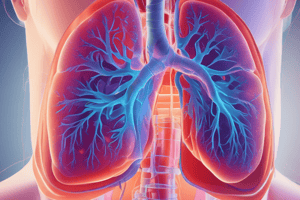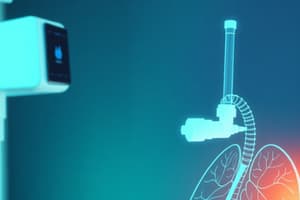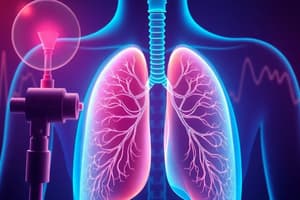Podcast
Questions and Answers
Which of the following calibration measurements would be unacceptable?
Which of the following calibration measurements would be unacceptable?
- 3.02 L
- 3.15 L (correct)
- 2.83 L (correct)
- 2.98 L
What is the acceptable range for a calibration check, expressed in milliliters?
What is the acceptable range for a calibration check, expressed in milliliters?
- 90 mL
- 291 - 309 mL (correct)
- 29.1 - 30.9 mL
- 2.91 - 3.09 mL
What is the primary purpose of a calibration check?
What is the primary purpose of a calibration check?
- To test for leaks in the equipment.
- To ensure the patient is using the device correctly.
- To ensure the device is delivering the correct volume of air. (correct)
- To assess the patient's lung capacity.
What should be done if a device fails a calibration check?
What should be done if a device fails a calibration check?
What is the likely cause of a calibration reading of 2.83 L?
What is the likely cause of a calibration reading of 2.83 L?
What does the term "Scoopy" refer to in this context?
What does the term "Scoopy" refer to in this context?
Based on the Figure, does the test show a positive bronchodilator response?
Based on the Figure, does the test show a positive bronchodilator response?
What is the formula used to calculate the bronchodilator response?
What is the formula used to calculate the bronchodilator response?
Based on the calculation in Table 1.9, does the test show a positive bronchodilator response?
Based on the calculation in Table 1.9, does the test show a positive bronchodilator response?
What percentage change is shown in Table 1.10?
What percentage change is shown in Table 1.10?
What does the term "Restriction" refer to in this context?
What does the term "Restriction" refer to in this context?
Based on the percentage change shown in Table 1.10, which of the following classifications is most likely?
Based on the percentage change shown in Table 1.10, which of the following classifications is most likely?
What are some of the possible causes of a bad spirometry test? (Select all that apply)
What are some of the possible causes of a bad spirometry test? (Select all that apply)
What is the formula for calculating the percentage change in FEV1 after a bronchodilator?
What is the formula for calculating the percentage change in FEV1 after a bronchodilator?
Which of the following is a sign of a poor start to a spirometry test?
Which of the following is a sign of a poor start to a spirometry test?
What is the significance of a 12% change in FEV1 or a 0.2 L increase in FVC after a bronchodilator?
What is the significance of a 12% change in FEV1 or a 0.2 L increase in FVC after a bronchodilator?
Which spirometry parameter is not used to measure bronchodilator response?
Which spirometry parameter is not used to measure bronchodilator response?
What is the primary cause of a scoop-shaped loop in a spirometry test?
What is the primary cause of a scoop-shaped loop in a spirometry test?
What is the significance of a skinny loop in a spirometry test?
What is the significance of a skinny loop in a spirometry test?
What is the best interpretation for a PFT with the following values: FEV1/FVC = 45%, FEV1 = 37%, FVC = 25%, TLC = 298%, FRC = 175%?
What is the best interpretation for a PFT with the following values: FEV1/FVC = 45%, FEV1 = 37%, FVC = 25%, TLC = 298%, FRC = 175%?
In the second PFT interpretation, what is the calculated % predicted for the FEV1?
In the second PFT interpretation, what is the calculated % predicted for the FEV1?
What is the best interpretation for a PFT with the following values: FEV1/FVC = 87%, FEV1 = 99%, FVC = 92%, TLC = 90%, FRC = 96%?
What is the best interpretation for a PFT with the following values: FEV1/FVC = 87%, FEV1 = 99%, FVC = 92%, TLC = 90%, FRC = 96%?
In a PFT showing a FEV1/FVC ratio of 78% and an FEV1 of 74%, what degree of severity is indicated?
In a PFT showing a FEV1/FVC ratio of 78% and an FEV1 of 74%, what degree of severity is indicated?
Which of the following is a valid calculation for determining the MVV?
Which of the following is a valid calculation for determining the MVV?
What is the appropriate action if variability in a PFT is > 20%?
What is the appropriate action if variability in a PFT is > 20%?
In a PFT, which parameter represents the total lung capacity?
In a PFT, which parameter represents the total lung capacity?
What is the main interpretation of a PFT with the following values: FEV1/FVC = 54%, FEV1 = 74%, FVC = 98%?
What is the main interpretation of a PFT with the following values: FEV1/FVC = 54%, FEV1 = 74%, FVC = 98%?
What is the best interpretation for the first PFT, where FEV1/FVC is 48%, FEV1 is 1.5, FVC is 2.1, TLC is 6.5, FRC is 3.5?
What is the best interpretation for the first PFT, where FEV1/FVC is 48%, FEV1 is 1.5, FVC is 2.1, TLC is 6.5, FRC is 3.5?
What best describes the second PFT where TLC is 7.12, RV is 3.6, and DLCO is 12.3?
What best describes the second PFT where TLC is 7.12, RV is 3.6, and DLCO is 12.3?
What is the best interpretation for the third PFT, where FRC is 1.86, TLC is 3.99, RV is 1.04, SVC is 2.96?
What is the best interpretation for the third PFT, where FRC is 1.86, TLC is 3.99, RV is 1.04, SVC is 2.96?
Based on the fourth PFT, what is the best interpretation for the patient's lung function? FRC is 4.26, TLC is 7.71, RV is 3.49, SVC is 4.22.
Based on the fourth PFT, what is the best interpretation for the patient's lung function? FRC is 4.26, TLC is 7.71, RV is 3.49, SVC is 4.22.
In the fourth PFT, why is there no definitive conclusion about the lung function?
In the fourth PFT, why is there no definitive conclusion about the lung function?
When determining the acceptability of a pulmonary function test using volume-time and flow-time graphs, what criteria must be met for the test to be considered acceptable?
When determining the acceptability of a pulmonary function test using volume-time and flow-time graphs, what criteria must be met for the test to be considered acceptable?
When assessing the quality of multiple pulmonary function test attempts, which attempt should be considered the best effort?
When assessing the quality of multiple pulmonary function test attempts, which attempt should be considered the best effort?
What can be concluded from the information provided in the table about the three pulmonary function test efforts?
What can be concluded from the information provided in the table about the three pulmonary function test efforts?
Which of the following is NOT a factor in determining the acceptability of a pulmonary function test?
Which of the following is NOT a factor in determining the acceptability of a pulmonary function test?
What is the primary factor in determining the acceptability of a pulmonary function test?
What is the primary factor in determining the acceptability of a pulmonary function test?
Flashcards
Acceptable Maneuvers
Acceptable Maneuvers
Tests with 3 maneuvers close in values; differences within 0.150 L.
Unacceptable Maneuvers
Unacceptable Maneuvers
Tests lacking repeatability; maneuvers disagree by more than 0.150 L.
Determining Best Effort
Determining Best Effort
The highest sum of FVC and FEV1 is reported as the best effort.
Flow/Volume Loops
Flow/Volume Loops
Signup and view all the flashcards
FRC Graphics
FRC Graphics
Signup and view all the flashcards
Post-Bronchodilator
Post-Bronchodilator
Signup and view all the flashcards
Positive Bronchodilator Response
Positive Bronchodilator Response
Signup and view all the flashcards
Forced Vital Capacity (FVC)
Forced Vital Capacity (FVC)
Signup and view all the flashcards
Restriction
Restriction
Signup and view all the flashcards
Obstruction
Obstruction
Signup and view all the flashcards
Large Airway Obstruction
Large Airway Obstruction
Signup and view all the flashcards
Poor Effort
Poor Effort
Signup and view all the flashcards
Spirometric Results
Spirometric Results
Signup and view all the flashcards
Good Effort in Spirometry
Good Effort in Spirometry
Signup and view all the flashcards
Poor Effort Indicators
Poor Effort Indicators
Signup and view all the flashcards
Bad Test Graphs
Bad Test Graphs
Signup and view all the flashcards
Causes of Poor Spirometry Results
Causes of Poor Spirometry Results
Signup and view all the flashcards
FEV1 Measurement
FEV1 Measurement
Signup and view all the flashcards
Bronchodilator Response
Bronchodilator Response
Signup and view all the flashcards
Bronchodilator Calculation Formula
Bronchodilator Calculation Formula
Signup and view all the flashcards
FEV1/FVC Ratio Use
FEV1/FVC Ratio Use
Signup and view all the flashcards
FEV1
FEV1
Signup and view all the flashcards
FVC
FVC
Signup and view all the flashcards
TLC
TLC
Signup and view all the flashcards
DLCO
DLCO
Signup and view all the flashcards
Air Trapping
Air Trapping
Signup and view all the flashcards
Poor Patient Effort
Poor Patient Effort
Signup and view all the flashcards
Calibration Check
Calibration Check
Signup and view all the flashcards
Calibration Limits
Calibration Limits
Signup and view all the flashcards
Acceptable Calibration Example
Acceptable Calibration Example
Signup and view all the flashcards
Unacceptable Calibration Example
Unacceptable Calibration Example
Signup and view all the flashcards
Maximum Voluntary Ventilation (MVV)
Maximum Voluntary Ventilation (MVV)
Signup and view all the flashcards
FVC (Forced Vital Capacity)
FVC (Forced Vital Capacity)
Signup and view all the flashcards
FEV1/FVC Ratio
FEV1/FVC Ratio
Signup and view all the flashcards
Pulmonary Function Test (PFT) Interpretation
Pulmonary Function Test (PFT) Interpretation
Signup and view all the flashcards
TLC (Total Lung Capacity)
TLC (Total Lung Capacity)
Signup and view all the flashcards
FRC (Functional Residual Capacity)
FRC (Functional Residual Capacity)
Signup and view all the flashcards
Lung Disease Types
Lung Disease Types
Signup and view all the flashcards
Study Notes
Pulmonary Function Testing - Graphics Interpretation and Quality Control
- Pulmonary function testing uses graphs and charts to evaluate test acceptability, determine which results to report, and ensure good effort.
- Key aspects include interpreting flow-volume loops, pre/post bronchodilator spirometry, and FRC graphics.
Determining Acceptability
- Acceptable maneuvers: Three maneuvers are very close in range, with two maneuvers agreeing within 0.150 L.
- Unacceptable maneuvers: Three maneuvers demonstrate lack of repeatability, with maneuvers not agreeing within 0.150 L.
Acceptable or Not?
- Curves are evaluated to ensure the highest sum of FVC and FEV1 values.
- The highest sum is considered the acceptable effort.
What Is Reported?
- The largest FVC and FEV1 values from acceptable maneuvers are reported.
- Reported values are from the best effort maneuver, regardless of which maneuver produces the highest result.
Determining Good Effort
- A good effort is characterized by a smooth flow-volume loop in which the "FEFmax" or "PEFR" shows a rapid fall and all components of the test are completed smoothly without interruptions
- "Poor effort" shows a poor execution and is incomplete with interruptions.
Poor Start of Test
- A poor start is characterized by an incomplete and irregular start to the flow-volume loop.
Significant Coughing
- Significant coughing during the test results in an irregular flow-volume loop, with pauses and unusual patterns.
Variable Flow
- A variable flow pattern during the test shows a fluctuating pattern of flow, without clear trends.
Early Termination
- Early termination is indicated by an abrupt stop to the flow-volume loop, before completion of the test.
FRC Graphics
- Proper technique results in straight lines on FRC graphics, overlapping smoothly.
- Bent or open lines indicate problems such as equipment issues, thermal drift (temperature calibration), or improper technique.
Calibration Checks
- Calibration checks should be performed daily.
- 3-liter calibration syringes are used at varying speeds, but consistent volumes.
- Documentation of calibration checks and leak testing is essential.
- Calibration must fall between 2.91-3.09 L to be considered acceptable. Problems outside this range may indicate equipment issues.
- Syringes with the standardized volumes are used for calibration checks.
Quality Control (QC)
- Biologic quality control uses healthy non-smokers for test validation.
- Establish the mean and standard deviation for FVC and FEV1.
- Measured values should fall within +/- 2 standard deviations of the mean.
- Remedial measures are required if values fall outside the acceptable range.
- Time sweep testing is used for verifying equipment degradation over time.
- Equipment function is checked over its full range of operation.
Calculations Required to Report Results
- Calculations convert exhaled air to body temperature to obtain accurate results.
- Air outside the body is different from air in the body and correction is required.
Maximum Voluntary Ventilation (MVV)
- MVV testing involves deep and rapid breathing for 12-15 seconds to estimate maximal breathing capacity.
- Techniques are needed to maintain accuracy.
- At least two efforts are needed, and repeatability of +/-10% is needed.
- The highest acceptable value is reported.
Calculating MVV
- Extrapolate the expired volume to one minute.
- MVV = FEV1 x 40
More Interpretation Practice
- Various examples of measured results and interpretation of pulmonary function tests (PFTs) are examined.
What is the best interpretation for this PFT?
- Different tables with predicted and measured values for PFTs and analysis of the possible diagnoses are presented. Obstructive, and restrictive disorders and various causes are listed.
Studying That Suits You
Use AI to generate personalized quizzes and flashcards to suit your learning preferences.



